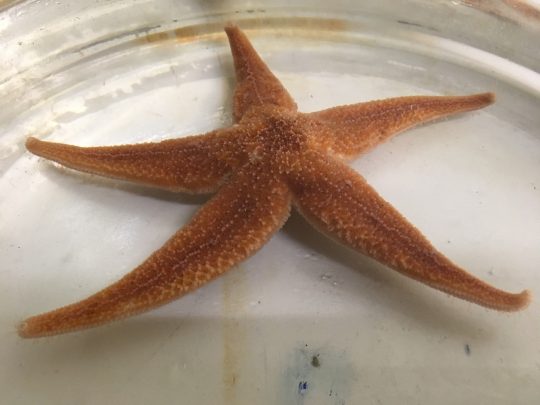
A male specimen of the starfish Asterias rubens in the laboratory of Professor Maurice Elphick in the School of Biological & Chemical Sciences at Queen Mary University of London.
News20 December 2018
Research on hormonal control of reproduction in starfish – an Anglo-Japanese collaboration
Categorised under: Grants
All around the coast of the UK there are millions of the common European starfish – Asterias rubens. Occasionally, we can see evidence of this abundance when starfish are washed up on our beaches during stormy weather. But how do these marine creatures reproduce to maintain this huge population? Starfish are either male or female and during the Spring they each release thousands of eggs or sperm into the sea. But they need to co-ordinate this “spawning” behaviour so that eggs and sperm are released at the same time. How do they do this? It has been discovered that they produce a hormone that triggers the maturation and release of eggs or sperm. The existence of this hormone has been known for sixty years but it was not until ten years ago that the chemical structure of the hormone was discovered by Professor Masatoshi Mita (Waseda University) and colleagues in Japan. Remarkably, it was found that the starfish hormone is very similar in structure to relaxin – a hormone in humans that causes relaxation of pelvic ligaments and softening of the cervix in preparation for childbirth. So relaxin-type hormones are ancient regulators of reproductive processes – from starfish to humans.
Professor Maurice Elphick at Queen Mary University of London is an expert on hormones in starfish and he has been awarded a Daiwa Foundation small grant to facilitate collaboration with Professor Mita. There is still much to be learnt about how the relaxin-type hormone controls spawning in starfish. Where are the cells that release the relaxin-type hormone located in the starfish body? How does the relaxin-type hormone trigger the gonads of starfish to release eggs or sperm into the sea. In 2019 Professor Mita will visit Professor Elphick’s laboratory in London and together they will address these and other questions, which will shed new light on this fascinating aspect of starfish biology. Furthermore, Professor Mita will train students in Professor Elphick’s group so that his many years of experience of research on starfish reproduction will be passed on to the next generation.
Are there any applications for this fundamental scientific research? Well maybe. Some starfish such as the crown-of-thorns starfish that lives on the Australian Great Barrier Reef are pests because when there are too many of them they feed on and destroy precious coral species. By learning more about how starfish reproduce it may be possible to find ways of managing starfish populations in the wild when it becomes necessary.
Written by Professor Maurice Elphick
Figure legends
-
-
- A male specimen of the starfish Asterias rubens in the laboratory of Professor Maurice Elphick in the School of Biological & Chemical Sciences at Queen Mary University of London. Sperm collected from this animal has been used as a source of DNA so that the complete genome sequence of this species can be determined as part of the Wellcome Trust Sanger Institute’s 25 Genomes Project (https://sangerinstitute.blog/2018/10/04/25-genomes-the-common-starfish/).
2. Professor Masatoshi Mita and Professor Maurice Elphick in front of the Queens’ Building at Queen Mary University of London during a previous collaborative visit in 2015.
-